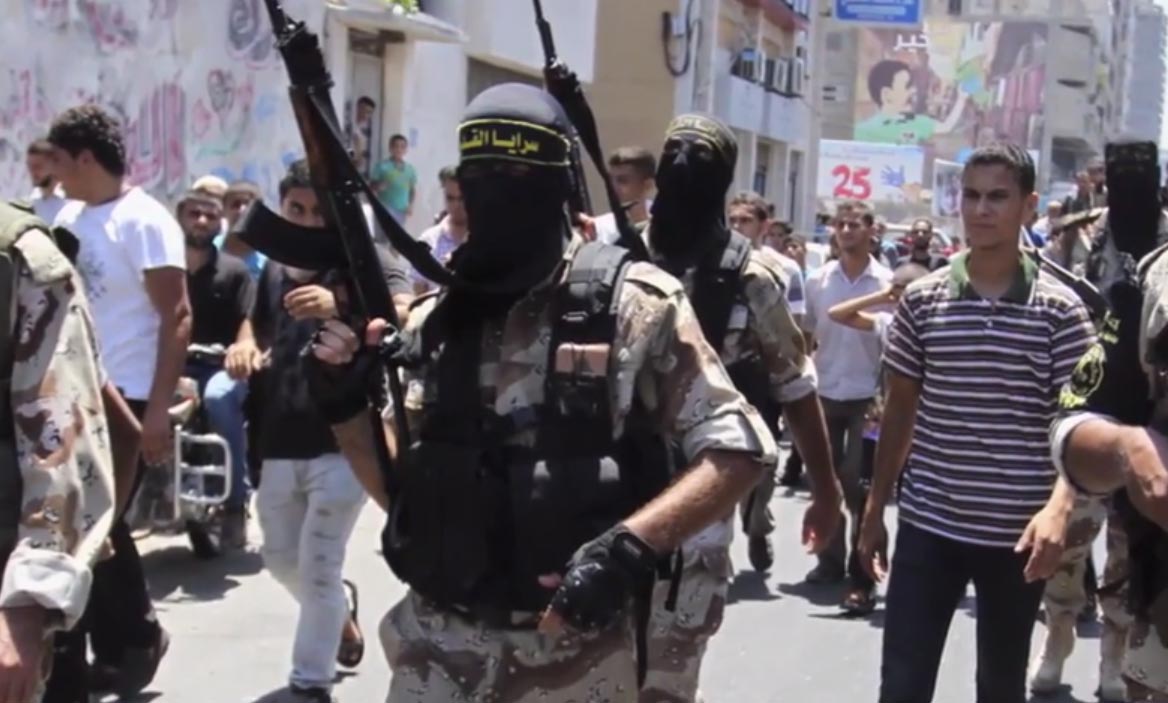The wave of terror pushing Palestinian teens in east Jerusalem and the West Bank threatens to swallow the Palestinian Authority (PA). Hamas, meanwhile, is trying to maintain its momentum in order to fuel its political campaign against Israel.
While the Palestinian Authority is trying to direct the wave of violence into a “popular resistance” resembling the first intifada, when the characteristics of the struggle were demonstrations, throwing stones, Molotov cocktails, and the use of “cold” weapons (knives) and not firearms, Hamas is attempting to incite all the territories including the Arab communities inside the Green Line to use all means, including firearms, in the fight against Israel.
The Hamas movement, which defines itself as an “opposition movement,” ignited the first Intifada in 1987. Today, Hamas doesn’t want to stay on the sidelines of the action. The Palestinian public, encouraged by the PA, has the impression that recent events are only the result of violent activities in east Jerusalem and the West Bank. The PA goes on to claim that the Gaza Strip is quiet because Hamas is interested in a long-term lull agreement with Israel in exchange for lifting the blockade and the construction of a seaport.
It is important to note that Hamas currently has a ceasefire agreement with Israel brokered by Egypt at the end of Operation Protective Edge.
Haniyeh’s Incendiary Speech
Consider this political backdrop when listening to the speech given by Ismail Haniyeh, deputy head of Hamas’ political bureau on October 9, 2015 in the Palestine Mosque in Gaza. He called for young people to march towards the fence with Israel and to confront the IDF; they did, and it led to many casualties on the Palestinian side. According to Palestinian sources, seven people were killed in the incident and another 145 others were injured.
Hamas is aware of the problem created by its image among the Palestinian public in light of the fact that even in the Arab towns in Israel there were riots and protests against Israeli policies. Therefore, Ismail Haniyeh announced in his Friday sermon that “Gaza will not give up its strategic role in the battle for Jerusalem, despite all the conspiracies, and the Gaza Strip is in a state of preparation for a confrontation (with Israel).”
Hamas has long charged that the security coordination between Israel and the PA has prevented the eruption of a popular intifada. Therefore, Haniyeh took advantage of recent events, calling on the PA to stop security coordination with Israel and declared that “the intifada is the only way towards liberation after we were ruined by negotiations.”
In his speech, Haniyeh tried to encourage Israeli Arabs to continue to riot and praised the Arab residents of Haifa, Beit Shean, the Negev, the [Arab] Triangle, and the Galilee for their “loyalty along the whole way.”
Hamas is concerned that this wave of terrorism and violence will not win the support of moderate Arab states and that West Bank residents don’t have the stamina to withstand the economic struggle against Israel.
Egypt and Jordan in recent days turned to the PA chairman and asked him to calm the situation. On October 9, Jordanian security forces dispersed demonstrations supporting the Palestinians in the territories. King Abdullah fears that unrest in the refugee camps in Jordan will be directed against his government.
For these reasons, Haniyeh in his speech called for “the establishment of an Islamic Arab security network that would provide the political and material support for the ‘Al-Quds Intifada’ in every way.”
Among the Palestinian public there has been sharp criticism directed against both Hamas and the PA that despite recent events and Palestinian casualties in the riots, the PA and Hamas are not finding a way to end the conflict between them and reach a national reconciliation.
Therefore, Haniyeh announced that “Hamas is ready for any step that will strengthen national unity, end the dispute, and start practical steps to build up the PLO.”
Fear of Violence along the Gaza Border
Haniyeh’s speech raises concerns that Hamas does not intend to continue the ceasefire agreement with Israel and is preparing to confront Israel.
It is not clear yet whether this is just incitement designed to show the residents of the West Bank, east Jerusalem, and the Gaza Strip Hamas’ support for the struggle, or if Hamas is also preparing public opinion in the Gaza Strip ahead of a new military confrontation with Israel.
At this stage, Hamas is encouraging both young Gazans to approach the eastern border of the Gaza Strip and confront Israeli soldiers on the border fence and young Palestinians in the West Bank and east Jerusalem to continue stabbing attacks. Later, Hamas may allow other organizations to fire rockets into Israel and perhaps begin rocket attacks itself in a measured manner.
One cannot rule out the possibility that Hamas will resume suicide attacks inside Israel through its military infrastructure in the West Bank and east Jerusalem. The October 13, 2015 shooting and stabbing on a Jerusalem bus and the vehicular murder by three terrorists is under investigation by Israeli security agencies. Palestinian sources suggest that the attacks have some markings of a Hamas operation.
To date, Hamas has been careful not to initiate or be dragged into another round of fighting with Israel following the severe damage caused to Gaza by Operation Protective Edge and the fact that it has not yet restored all the military infrastructures that were damaged. However, the mood and opinion in the Gaza Strip have an important influence on the decision-making process for Hamas.
In the event of escalation and if the general atmosphere in the Gaza Strip is that Gazans are willing to tackle the harsh results of another round of fighting with Israel in solidarity with the residents of the West Bank, Hamas may act. Also, the fight for control of the Temple Mount and “saving the Al-Aqsa mosque,” is not a fight Hamas can ignore and Hamas could launch massive and sustained rocket attacks against Israel.









